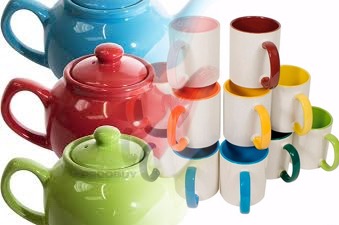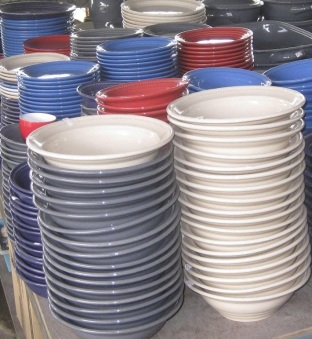Kementerian Kesihatan mengambil maklum laporan oleh akhbar The Star pada 9 Julai 2016 di mukasurat 14 bertajuk “Health risk in household ware”. Laporan itu menyatakan bahawa kajian awal yang dijalankan oleh pihak Malaysian Association of Standard Users bersama Greenfinite Sdn Bhd mendapati bahawa kesemua lapan (8) perkakas dapur seramik yang diuji mereka dengan kaedah X-ray Fluorescence Spectrometry mengandungi logam berat dan bahan kimia pada paras yang tinggi.
Mengikut subperaturan 28(4), Peraturan-Peraturan Makanan 1985 di bawah Akta Makanan 1983, barangan seramik yang digunakan dalam penyediaan, pembungkusan, penstoran, penyerahhantaran atau pendedahan makanan perlu diuji mengikut Malaysian Standard MS 1SO 6846-1 Ceramic ware, glass ceramic ware and glass dinnerware in contact with food – Release of lead and cadmium – Part 1: Test method. Jumlah plumbum dan cadmium yang dibebaskan daripada barangan seramik tersebut tidak boleh melebihi kadar maksimum yang dibenarkan sebagaimana yang ditetapkan dalam peraturan tersebut. Kegagalan mematuhi peraturan tersebut adalah satu kesalahan dan jika disabit kesalahan, boleh didenda tidak melebihi RM5,000 atau dipenjara tidak melebihi tempoh dua (2) tahun.

Kementerian Kesihatan ingin menjelaskan bahawa kaedah analisis X-ray Fluorescence Spectrometry yang digunakan oleh pihak Malaysian Association of Standard Users adalah berbeza dengan kaedah yang digunakan oleh Kementerian Kesihatan. Malaysian Association of Standard Users menggunakan kaedah analisis X-ray Fluorescence Spectrometryuntuk mengukur kandungan logam berat yang terdapat dalam perkakas dapur seramik dan bukannya kandungan logam berat yang dibebaskan oleh perkakas dapur seramik. Dalam hal ini, kaedah analisis yang dijalankan oleh Kementerian Kesihatan sepertimana yang diperuntukkan dalam subperaturan 28(4), Peraturan-Peraturan Makanan 1985 adalah lebih sesuai kerana ia menganalisa kandungan logam berat yang dibebaskan oleh perkakas dapur seramik ke dalam makanan bagi tujuan menilai risiko kepada pengguna.
Dalam pada itu, Kementerian Kesihatan telah menjalankan pemantauan ke atas perkakas dapur seramik yang dijual di pasaran dan sehingga kini hasil pemantauan menunjukkan bahawa hanya satu (1) perkakas dapur seramik dikesan membebaskan logam berat plumbum melebihi had yang dibenarkan.

Kementerian Kesihatan sentiasa peka dan prihatin terhadap perkara-perkara yang boleh mengancam keselamatan pengguna. Dengan penguatkuasaan yang bersungguh dan berterusan, Kementerian Kesihatan memberi jaminan bahawa tahap keselamatan dan kualiti makanan adalah terkawal. Pengguna boleh menghubungi Jabatan Kesihatan Negeri atau Pejabat Kesihatan Daerah yang terdekat atau melalui laman webhttp://moh.spab.gov.my atau lamanFacebook Bahagian Keselamatan dan Kualiti Makanan www.facebook.com/bkkmhq jika terdapat aduan berkaitan keselamatan makanan.
Sekian, terima kasih.
DATUK DR. NOOR HISHAM ABDULLAH
Ketua Pengarah Kesihatan Malaysia
10 Julai 2016
Thestar – Saturday, 9 July 2016
Health risk in household ware
on coloured ceramic plates and cups widely used in households showed that one of the samples had 10,600 times more lead than allowed, and this might cause a decline in mental functioning.
Malaysian Association of Standards Users CEO Ratna Devi said one of the eight types of kitchenware that Standards Users and Greenfinite Sdn Bhd tested found 53,003 part per million (ppm) of lead compared with the estimated five ppm (0.8mg/dm sq) limit allowed in the Food Act 1983 and Food Regulations 1985.
The test was only done for coloured and decorated glazes of ceramic kitchenware (plates and cups).
On Tuesday, the two bodies carried out tests on kitchenware and toys for chemical elements as regulated in the Safety Standards for Toys Regulations 2009 and the United States Consumer Product Safety Commission requirements.
From the tests, all eight types of common ceramic kitchenware and five out of 10 toys sold in supermarkets were found to have high levels of heavy metals and chemical elements.
The products were tested for arsenic, antimony, mercury, chromium, selenium, cadmium, barium, lead and gasses by using a portable X-ray Fluorescence Spectrometry that complies with US regulations.
Ratna said coloured glaze on ceramic kitchenware posed a greater concern than toys because they contained not only lead but also cadmium or other chemical elements that were not supposed to exceed the level in volume/mass.
“Upon contact with food, toxic substances may be released,” she told a press conference to announce the results of the tests.
“The authorities must carry out tests on kitchenware to ensure those with harmful substances are taken off the market,” said Ratna.
She said that the food and regulation Acts provided for control and inspection of ceramic ware and the maximum permitted release level was 0.8mg/dm square for lead and 0.07mg/dm square for cadmium.
One of the 10 toys tested showed that it had 1,819 ppm amount of lead, 20 times more than 90 ppm limit allowed, she said.
“The Health Ministry should also carry out blood tests on the people to find out the level of heavy metal exposure,” she said.
Market surveillance should also be tightened, she said, adding that Standards Users have also asked the Government to come up with an approved certification mark to distinguish ceramic tableware which complied with regulation from those which do not.
“In 2009, we asked for the certification mark but this was not taken up,” she said, adding that manufacturers also needed to ensure that the products they sell were safe.










